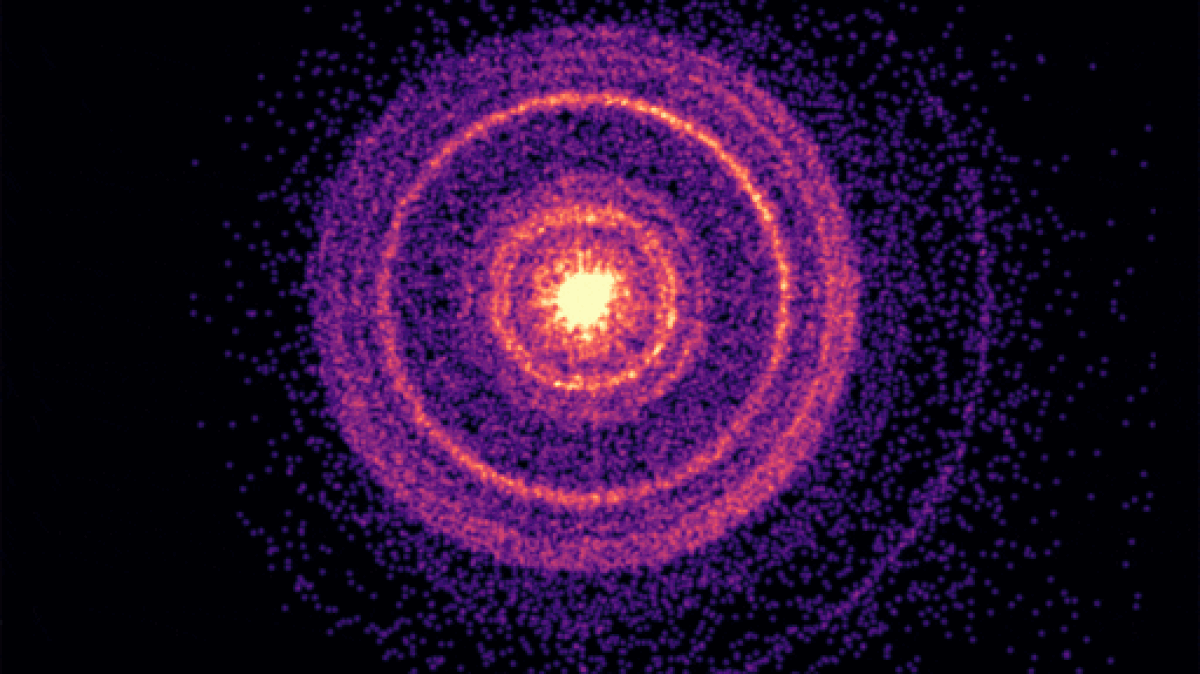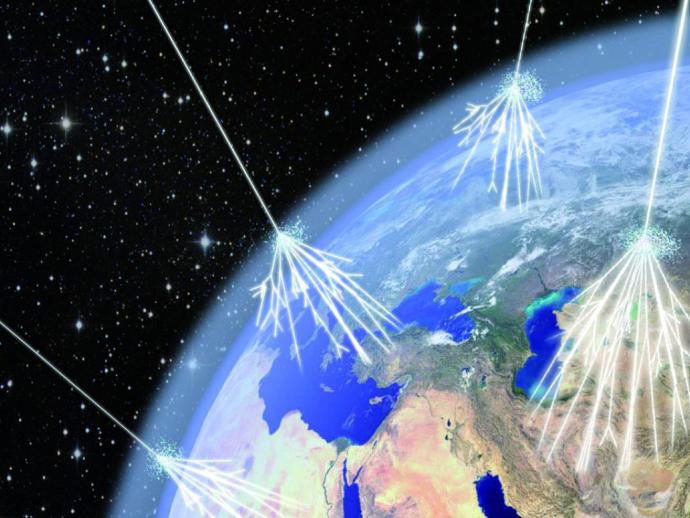Gamma-ray bursts (GRB)

Expanding dust-scattering rings
observed by the X-ray telescope onboard
the Swift satellite after gamma-ray
burst 221009A
Gamma-ray bursts are the most powerful explosions in the Universe. They are produced in cataclismic events such as the core collapse of a massive star or the merger of two compact objects. Despite more than fifty years of research, several aspects of their physical processes are still under debate. Our research activity on GRBs includes radio observations, multi-wavelength data analysis, modelling and interpretation of the emission, population studies, and development of predictions to guide strategies and the construction of new observational facilities.

observed by the X-ray telescope onboard
the Swift satellite after gamma-ray
burst 221009A
Active Galactic Nuclei (AGN) 
Artist's impression of an AGN.
Credit: NuStar, NASA
Active
galactic nuclei are regions at the center of galaxies that host a
super-massive black hole (SMBH) surrounded by an accretion disk composed
of matter that is gravitationally bound to the SMBH and slowly spirals
into it, accreting its mass. AGNs produce large-scale relativistic jets
that can be observed at all wavelengths. [...]
Multi-messenger (MM) astrophysics with gravitational waves (GW) and electromagnetic (EM) radiation

Artist's impression of the outflows and
emission components that follow a
binary neutron star merger. Credit:
S. Ascenzi, S. Ronchini (GSSI)
The
merger of a neutron star (NS) with another compact object, such as a
black hole or another NS, is one of the loudest sources of gravitational
waves (GW) in the Universe. Matter that does not fall promptly beyond
the event horizon of a remnant black hole (if any), can also produce a
wide range of electromagnetic (EM) emission signatures, including a
kilonova (the nuclear-decay-powered emission from the merger ejecta) and
the emission related to the launch of a relativistic jet.
Multi-messenger studies of these sources, that combine the information
from the GW and EM messengers, have the potential to revolutionise our
understanding of many branches of astrophysics, but also cosmology,
nuclear physics, and fundamental physics. Our group is at the forefront of these studies, and it is involved in the Einstein Telescope (ET)
collaboration, that gathers scientists interested in building the next
generation GW observatory in Europe. We are also part of the
Electromagnetic counterparts at the Very Large Telescope (ENGRAVE)
collaboration, that gathers astronomers who observe and characterize
the EM counterparts of these GW sources with the instruments of the
European Southern Observatory (ESO) and beyond.
 |
| Artist's impression of an AGN. Credit: NuStar, NASA |
Active galactic nuclei are regions at the center of galaxies that host a super-massive black hole (SMBH) surrounded by an accretion disk composed of matter that is gravitationally bound to the SMBH and slowly spirals into it, accreting its mass. AGNs produce large-scale relativistic jets that can be observed at all wavelengths. [...]
Multi-messenger (MM) astrophysics with gravitational waves (GW) and electromagnetic (EM) radiation

Artist's impression of the outflows and
emission components that follow a
binary neutron star merger. Credit:
S. Ascenzi, S. Ronchini (GSSI)
The
merger of a neutron star (NS) with another compact object, such as a
black hole or another NS, is one of the loudest sources of gravitational
waves (GW) in the Universe. Matter that does not fall promptly beyond
the event horizon of a remnant black hole (if any), can also produce a
wide range of electromagnetic (EM) emission signatures, including a
kilonova (the nuclear-decay-powered emission from the merger ejecta) and
the emission related to the launch of a relativistic jet.
Multi-messenger studies of these sources, that combine the information
from the GW and EM messengers, have the potential to revolutionise our
understanding of many branches of astrophysics, but also cosmology,
nuclear physics, and fundamental physics. Our group is at the forefront of these studies, and it is involved in the Einstein Telescope (ET)
collaboration, that gathers scientists interested in building the next
generation GW observatory in Europe. We are also part of the
Electromagnetic counterparts at the Very Large Telescope (ENGRAVE)
collaboration, that gathers astronomers who observe and characterize
the EM counterparts of these GW sources with the instruments of the
European Southern Observatory (ESO) and beyond.
 |
| Artist's impression of the outflows and emission components that follow a binary neutron star merger. Credit: S. Ascenzi, S. Ronchini (GSSI) |
The
merger of a neutron star (NS) with another compact object, such as a
black hole or another NS, is one of the loudest sources of gravitational
waves (GW) in the Universe. Matter that does not fall promptly beyond
the event horizon of a remnant black hole (if any), can also produce a
wide range of electromagnetic (EM) emission signatures, including a
kilonova (the nuclear-decay-powered emission from the merger ejecta) and
the emission related to the launch of a relativistic jet.
Multi-messenger studies of these sources, that combine the information
from the GW and EM messengers, have the potential to revolutionise our
understanding of many branches of astrophysics, but also cosmology,
nuclear physics, and fundamental physics. Our group is at the forefront of these studies, and it is involved in the Einstein Telescope (ET)
collaboration, that gathers scientists interested in building the next
generation GW observatory in Europe. We are also part of the
Electromagnetic counterparts at the Very Large Telescope (ENGRAVE)
collaboration, that gathers astronomers who observe and characterize
the EM counterparts of these GW sources with the instruments of the
European Southern Observatory (ESO) and beyond.

